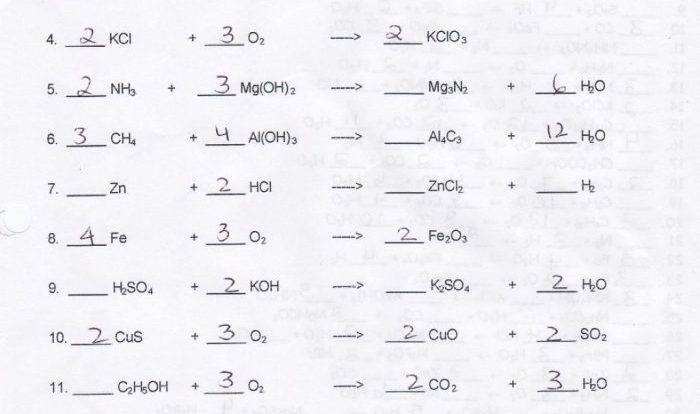Chemistry chapter 8 review chemical equations and reactions – Chemistry Chapter 8 Review: Chemical Equations and Reactions delves into the fundamental principles governing chemical reactions, providing a comprehensive understanding of the language, types, and mechanisms of these transformations. This chapter equips learners with the knowledge and skills necessary to analyze, predict, and manipulate chemical reactions in various contexts.
Chemical equations, the symbolic representations of chemical reactions, serve as the foundation for understanding the stoichiometry, energy changes, and equilibrium dynamics of these processes. Balancing chemical equations ensures that the law of conservation of mass is upheld, while reaction rates and equilibrium principles shed light on the kinetics and thermodynamics of chemical systems.
Chemical Equations
Chemical equations are symbolic representations of chemical reactions. They show the reactants, products, and coefficients of a reaction. The reactants are the substances that are consumed in the reaction, while the products are the substances that are formed. The coefficients are numbers that indicate the relative amounts of reactants and products involved in the reaction.
Chemical equations must obey the law of conservation of mass, which states that mass cannot be created or destroyed in a chemical reaction. This means that the total mass of the reactants must be equal to the total mass of the products.
Types of Chemical Reactions
Chemical reactions can be classified into different types based on various criteria, such as the type of reactants, the type of products, and the energy changes that occur.
- Type of reactants:Reactions can be classified as combination reactions, decomposition reactions, single-displacement reactions, double-displacement reactions, and combustion reactions.
- Type of products:Reactions can be classified as synthesis reactions, decomposition reactions, and exchange reactions.
- Energy changes:Reactions can be classified as exothermic reactions, endothermic reactions, and thermoneutral reactions.
Balancing Chemical Equations
Balancing chemical equations is essential to ensure that they obey the law of conservation of mass. Balancing an equation involves adjusting the coefficients of the reactants and products so that the number of atoms of each element is the same on both sides of the equation.
There are several methods for balancing chemical equations, including the trial-and-error method and the oxidation number method.
Stoichiometry
Stoichiometry is the study of the quantitative relationships between reactants and products in chemical reactions. It is used to calculate the moles of reactants and products involved in a reaction, as well as the limiting reactant and the theoretical yield.
The limiting reactant is the reactant that is completely consumed in a reaction, while the theoretical yield is the maximum amount of product that can be formed in a reaction.
Reaction Rates
The reaction rate is a measure of how fast a chemical reaction occurs. It is affected by several factors, including the concentration of the reactants, the temperature, the surface area of the reactants, and the presence of a catalyst.
A catalyst is a substance that speeds up a chemical reaction without being consumed in the reaction.
Equilibrium
Chemical equilibrium is a state in which the forward and reverse reactions of a chemical reaction occur at the same rate. This means that the concentrations of the reactants and products do not change over time.
The position of equilibrium can be affected by several factors, including the concentration of the reactants and products, the temperature, and the pressure.
Thermochemistry: Chemistry Chapter 8 Review Chemical Equations And Reactions
Thermochemistry is the study of the energy changes that occur in chemical reactions. It is used to calculate the enthalpy, entropy, and free energy of a reaction.
The enthalpy of a reaction is the change in heat content that occurs in the reaction. The entropy of a reaction is the change in disorder that occurs in the reaction. The free energy of a reaction is the change in energy that is available to do work.
Electrochemistry
Electrochemistry is the study of the relationship between electricity and chemical reactions. It is used to study the properties of electrochemical cells, which are devices that convert chemical energy into electrical energy or vice versa.
Electrochemical cells are used in a variety of applications, including batteries, fuel cells, and electroplating.
Nuclear Chemistry
Nuclear chemistry is the study of the structure and properties of the atom. It is also concerned with the reactions that occur between atoms, such as nuclear fission and nuclear fusion.
Nuclear reactions can release large amounts of energy, which is why they are used in nuclear power plants and nuclear weapons.
Organic Chemistry
Organic chemistry is the study of the structure, properties, and reactions of organic compounds. Organic compounds are compounds that contain carbon, and they are found in all living things.
Organic chemistry is used to develop new drugs, plastics, and other materials.
FAQ Compilation
What is the significance of balancing chemical equations?
Balancing chemical equations ensures that the law of conservation of mass is upheld, meaning that the total mass of the reactants is equal to the total mass of the products.
How do reaction rates affect chemical reactions?
Reaction rates determine the speed at which chemical reactions occur, influencing the efficiency and practicality of various chemical processes.
What is the role of equilibrium in chemical systems?
Equilibrium represents a dynamic state where the forward and reverse reactions of a chemical system occur at equal rates, resulting in no net change in the concentrations of reactants and products.
